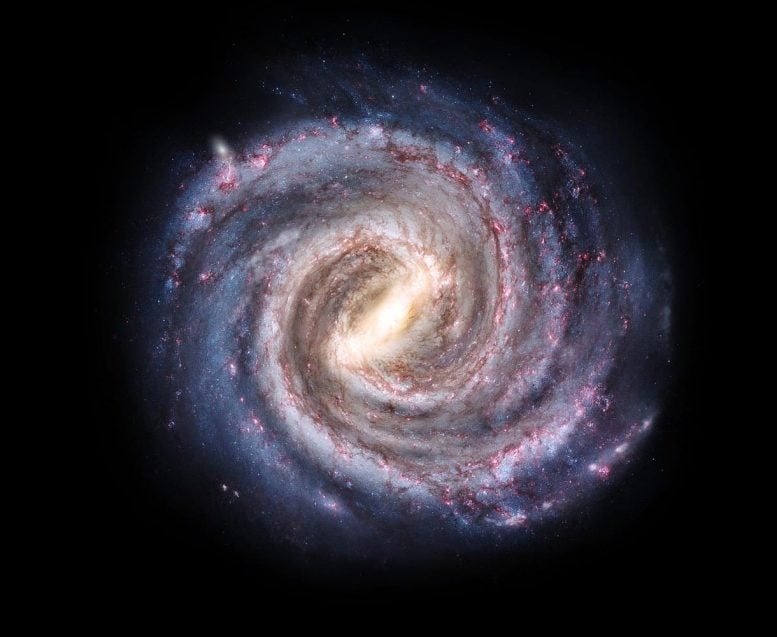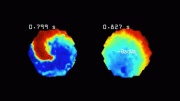The spin of the Milky Way’s galactic bar, which is made up of billions of clustered stars, has slowed by about a quarter since its formation, according to a new study by researchers at University College London and the University of Oxford.
For 30 years, astrophysicists have predicted such a slowdown, but this is the first time it has been measured.
The researchers say it gives a new type of insight into the nature of dark matter, which acts like a counterweight slowing the spin.
In the study, published in the Monthly Notices of the Royal Astronomical Society, researchers analyzed Gaia space telescope observations of a large group of stars, the Hercules stream, which are in resonance with the bar – that is, they revolve around the galaxy at the same rate as the bar’s spin.
These stars are gravitationally trapped by the spinning bar. The same phenomenon occurs with Jupiter’s Trojan and Greek asteroids, which orbit Jupiter’s Lagrange points (ahead and behind Jupiter). If the bar’s spin slows down, these stars would be expected to move further out in the galaxy, keeping their orbital period matched to that of the bar’s spin.
The researchers found that the stars in the stream carry a chemical fingerprint – they are richer in heavier elements (called metals in astronomy), proving that they have traveled away from the galactic center, where stars and star-forming gas are about 10 times as rich in metals compared to the outer galaxy.
Using this data, the team inferred that the bar – made up of billions of stars and trillions of solar masses – had slowed down its spin by at least 24% since it first formed.
Co-author Dr. Ralph Schoenrich (UCL Mullard Space Science Laboratory) said: “Astrophysicists have long suspected that the spinning bar at the center of our galaxy is slowing down, but we have found the first evidence of this happening.
“The counterweight slowing this spin must be dark matter. Until now, we have only been able to infer dark matter by mapping the gravitational potential of galaxies and subtracting the contribution from visible matter.
“Our research provides a new type of measurement of dark matter – not of its gravitational energy, but of its inertial mass (the dynamical response), which slows the bar’s spin.”
Co-author and PhD student Rimpei Chiba, of the University of Oxford, said: “Our finding offers a fascinating perspective for constraining the nature of dark matter, as different models will change this inertial pull on the galactic bar.
“Our finding also poses a major problem for alternative gravity theories – as they lack dark matter in the halo, they predict no, or significantly too little slowing of the bar.”
The Milky Way, like other galaxies, is thought to be embedded in a ‘halo’ of dark matter that extends well beyond its visible edge.
Dark matter is invisible and its nature is unknown, but its existence is inferred from galaxies behaving as if they were shrouded in significantly more mass than we can see. There is thought to be about five times as much dark matter in the Universe as ordinary, visible matter.
Alternative gravity theories such as modified Newtonian dynamics reject the idea of dark matter, instead seeking to explain discrepancies by tweaking Einstein’s theory of general relativity.
The Milky Way is a barred spiral galaxy, with a thick bar of stars in the middle and spiral arms extending through the disc outside the bar. The bar rotates in the same direction as the galaxy.
Reference: “Tree-ring structure of Galactic bar resonance” by Rimpei Chiba and Ralph Schönrich, 19 April 2021, Monthly Notices of the Royal Astronomical Society.
DOI: 10.1093/mnras/stab1094
The research received support from the Royal Society, the Takenaka Scholarship Foundation, and the DiRAC supercomputing facility of the Science and Technology Facilities Council (STFC).










It seems a good proof of the existence of aether as the medium of light, filling up the entire visible space of the universe including the space between electrons and nuclei, which is a direct conclusion from the disproof of special relativity (https://www.researchgate.net/publication/297527784_Challenge_to_the_Special_Theory_of_Relativity ). Aether is a fluid with mass (i.e. inertia and gravitation), velocity, acceleration, temperature, pressure, viscosity, compressibility, like an ideal gas because its viscosity is very very very small. Its gravitation helps bind stars in galaxies. Its pressure pushes galaxies away from each other to create the illusion of “the expansion of space”. Its density change forms so called “gravitational lens”. It delivers all electromagnetic forces. Light and other electromagnetic waves are waves of aether. The wave in the particle-wave duality is also the wave of aether because every particle is bathed in aether and any motion of the particle disturbs its surrounding aether. Cherenkov radiation is the shock wave of aether. High speed motion in aether makes cesium atomic clock tick more slowly than a stationary one and leads muons to decay more slowly than those in a lab. Most so-called relativistic effects are actually the effects of aether.
Aether, huh? None of what you just rambled off even comes close to real science, here’s why. If this aether is the cause of gravitational lensing (using a large body of gravity to bend light around so you can magnify what’s behind said large body of gravity) then the less mass the more aether, thus the more the gravitational lensing effect would take place. We see the opposite, sorry.
The more mass a celestial body has, the stronger gravitation it has which compresses aether similar to that the earth compresses air.
Is aether the principal media/matter of the universe AND IS electromagnetic POLarity the principal motive force?
“Using this data, the team inferred that the bar – made up of billions of stars and trillions of solar masses – had slowed down its spin by at least 24% since it first formed”. They infer it, have no proof of it, but gain prestige and funds through this inference without evidence. Good job that. I infer that the positive way outweighs the ways out of science into politics. And that is a ways out of reality into fantasy.
Utter nonsense. They’ll look back on this time in astrophysics and laugh at the fact astronomers actually made up an “inferred” form of matter when the real answer was staring them in the face all along. The only force we know imperically is the electromagnetic force. Period.
Sigh, here’s the big problem they aren’t telling you. Gravitational time dilation. The closer you are to a black hole, or in this case a supermassive black hole, the slower time ticks for you compared to the relative universe. This has been proven countless times, therefore we come to a conundrum much like we always do in astronomy. Let’s pretend you have a spaceship orbiting a planet that orbits close to a black hole. This concept was played with by the movie interstellar, but this part never explained. You send people down to the planet where time slows for them but keeps going normal for you. Every 50 minutes on the planet is 6 years to the person in the spaceship orbiting said planet. So what would the person see if they had a telescope on their space ship and zoomed in on their buddy on the planet? Would they view their buddy just going remarkably slow, or would it look normal because you can’t slow down light?
We can take this a step farther, let’s say the two parties have a line of communication. The guy orbiting the planets messages would be instantly told to the person on the planet, but what happens when the person on the planet tries to instantly reply? Theoretically it would space out the response, to where you would be stuck listening to almost the same letter of the response for months. Yet once again, we have proven you can’t slow down light, so what if they are using lasers to communicate with instead? Would the response just be red shifted but still able to be understood?
This is the problem we get into when viewing the middle of galaxies and trying to measure their visible mass vs the speed at which they are spinning. The stars closest to the black hole are believed to be speeding up, much like an ice skater pulling their arms in as they spin. Yet what I just stated theorizes we would not actually see this effect, but to us it would appear to do the opposite and slow down. This is the puzzle that astronomers can’t figure out, how galaxies still spin too fast for their visible mass, accounting for most of this. This is where dark matter comes in, it’s a filler for why every Galaxy’s stars move too fast, especially on the outside of their arms. You also get to include the faster something goes the slower it ages, so these stars close to the supermassive black hole in our Galaxy are basically time traveling. The only problem is the red shift from the stars at the heart of a galaxy is equal to the redshift from the stars at the tips of the arms. So where is the missing gravity that has to exist at the edges of galaxies to make this effect occur? Dark matter is our goto, but I’m sure we are missing some step of this gravitational time dilation.
Stephen hawking actually just released his math proving black holes can never get smaller at their boarder, the event horizon. This flies completely in the face of his previous research stating that black holes leak radiation back into space, thus slowly shrinking (Hawkings radiation). Yet both seem to mathematical work out, so how can this be? It’s the light socket test with electrons all over again, simply observing an event will change the outcome of said event. So thus we figured we would see this slowing down of the stars towards the middle of galaxies, and this article states we finally measured it for the first time, and it is indeed true. Good read, and good job to the scientists leading this research and doing the brain melting math behind it.